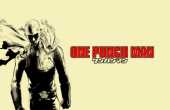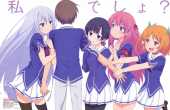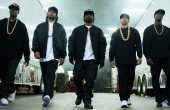Adam
Toronto writer. Specializes in film, music, anime and video games. Loves dogs. And cats. Animals in general are pretty cool, really
Contributor I
- Plebian Penman
- Lurker
- Sharp-Eyed Citizen
- ?
- Articles
4 - Featured
4 - Comments
12
- Ext. Comments
9 - Processed
6 - Revisions
6
- Topics
6 - Topics Taken
2 - Notes
6
- Topics Proc.
6 - Topics Rev.
1 - Tides
1
- Tides Proc.
0 - Tides Rev.
0 - Tide Comments
1
- Points
777 - Rank
186 - Score
361
Latest Articles
Latest Topics
High School in TV - Idealistic vs. RealisticTalk about the different ways that high school has been portrayed in TV, in particular the two subsets of Idealistic (ie. Saved By the Bell, That's So Raven) and Realistic (Daria, Freaks and Geeks). Compare these two portrayals to each other as well as the real life experience of high school.
|
Mother's influence on indie gamesExamine the influence the JRPG series Mother has had on recent indie games, with examples being Undertale, Lisa, OFF, Space Funeral, Ib and Anodyne. Talk about how it's atmosphere and mix of quirky humor and cosmic horror has been modified and utilized by modern indie developers. |
Written Criticism vs. Video CriticismIn the past few years, we've seen a shift in popularity from written media criticism to video criticism. It's becoming more and more difficult to just be a writer, as you're now demanded to a do a video or record a podcast alongside it. In this new landscape, have there been people left by the wayside? Is it still possible to become established solely through writing?
|
The Life and Death of CommunityWrite a retrospective on the NBC comedy series Community, including its troubled production, various cast changes, and the numerous ups and downs during its broadcast history. Talk about the individual character arcs and storylines throughout the seasons and how they changed to reflect what was going on behind the camera.
|
Film in a Post-Ferguson AmericaTalk about the recent yearly trend of films addressing the history of racism in America, including 12 Years a Slave (2013), Selma (2014), Straight Outta Compton (2015) and the upcoming The Birth of a Nation (2016). Examine these films in the context of the recent resurgence of racial tension in America, as well as the reaction of calling them "anti-white" that some people have had.
|
Monetizing Writing in 2016Examine the current state of professional writing, journalistic and/or fiction, in the digital age, and the comforts as well as the difficulties that aspiring writers may have making a living off their work. For journalism, you can talk about how modern outlets rely increasingly on easily replaceable writers repeating the news instead of defined personalities and opinions, as well as the reliance on sponsored content for income resulting in a rift between the editors and writers. For fiction, you could talk about how digital and self-publishing has made it more difficult for large publishing houses to bring on new writers and compensate them properly, while at the same time self-publishing for a living carries it's own risks of being unable to easily reach a larger audience.
|
Latest Tides
∼∼∼∼∼∼∼∼∼∼∼∼ Tidearticle | anime Majikoi and the Value of Being DifferentMaji de Watashi ni Koi Shinasai!, or Majikoi for short, is a visual novel that is, quite simply, one of the most charming visual novels ever written. It centers on a group of childhood friends living in an bustling city populated by the descendants of warriors. It features a huge and colorful cast of characters, each with their own distinct personality and moments to shine. Utilizing a unique blend of genres including romance, action and drama, it creates something completely new the likes of which has never really been seen before. That last part is key – never been seen before. The "harem" genre is a popular subset of anime and manga that focuses on a typically male protagonist and the multiple women whose affections he earns. It's a genre that, thankfully, doesn't take itself very seriously most of the time, but it's still awash with the same tropes, character types and storylines. Majikoi not only averts these cliches, but makes something different by building on them and specifically pointing them out. Here I talk about all the ways Majikoi differentiates itself from typical harem and ecchi tropes and storylines, and, hopefully, convince you to give it a good read. |
Latest Comments
| “Bro Games” and the Gamer Divide | |
Not necessarily. Fighting is something that very few people generally do, so when people read those manga they don’t take it as “Oh, I should fight because anyone can do it!” they take it as “Oh, I should reach for my dreams!”. Whereas romance is a very real part of almost everyone’s life, so the message that harem stories send can be applied much more literally. | Harem Anime and Manga - Expectations vs. Reality |
I absolutely love Bojack Horseman and the way it balances comedy and dark themes. I haven’t seen it yet, but I hear that Moral Orel does the same. | Bojack Horseman: Balancing Humor and Dark Themes |
Life is not in absolutes. You’re not either perfect or mediocre with no middle ground in between. In most cases, “perfection” is impossible and striving for it will only hurt yourself in the long run. As someone who suffers from Obsessive-Compulsive Disorder I know this. Instead of striving for perfection, people should strive to do the best they can. I don’t think the people you listed were trying to be perfect either, they were trying to contribute to humanity with the best of their abilities. Sometimes there are limitations that people can’t control, the key is not to try to overcome them, but to learn to work within them. Body type can be one of those limitations. | Overweight Superheroes and Supervillains |
Personally, I believe that, in both fiction and real life, a person’s body type, be they skinny, muscular or overweight, is not important at all. What’s truly important is their character. I’m skinny and I look up to Steve Rogers immensely, not because he’s muscular, but because he’s a hero who always tries to do the right thing. If an overweight person were to feel bad because all their superhero role models are fit, they’re thinking about things completely the wrong way. Being truly heroic transcends race, gender or body type. They should ask themselves: Would their heroes care what they look like, or would they see the person underneath? | Overweight Superheroes and Supervillains |
I don’t think making the sequel unrelated to the first one would make it ineffectual at all. The themes of Life is Strange have been properly hammered home, nothing can take away the impact of the ending and what it was trying to say. But at the same time, Max’s story is over, and there would be no point in having her reappear aside from novelty’s sake. Going with a completely unrelated setting and cast for the sequel is the way to go, in my opinion. I think it would be great if it focused on adult characters, as the first one was entirely from a teenager’s perspective. Maybe have four games to represent childhood, adolescence, adulthood and elder years and the common themes of them all. | Life Is Strange: The Illusion of Choice, Part II |
Technically they came from Japan, but Flower Travellin’ Band fits right in with this scene. Great psychedlic stuff, I’d even say proto-metal. https://youtu.be/BxB55yaWG-I | Swinging Los Angeles: L.A.'s Forgotten Role as a Psychedelic Rock Mecca |
I’d say that, as far as biopics go, it was surprisingly willing to show the good and bad parts of most people involved. The negative aspects of Ice Cube and Eazy-E were portrayed, and even the manager who was ripping them off wasn’t totally demonized. I agree that the portrayal of Dr. Dre wasn’t the most balanced, though. Apparently his abuse of women was originally in the film but was cut for time reasons. | The New Wave of Biopics |




I enjoy both games that can be classified as “Bro” and role-playing games and see the division between the two genres illustrates how sexism works perfectly. Men enjoy role-playing games as they are tailored to be genderless, but women have harder time getting into the bro game community. Luckily there are several multiplayer games (Overwatch, MMOs) that appeal to women so it’s not like all multiplayer games are completely off-limits for them.